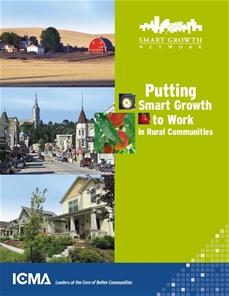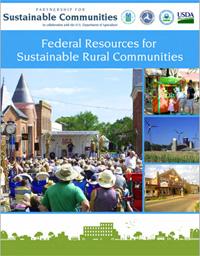Smart Growth in Small Towns and Rural Communities
On this page:
Background
Small towns and rural communities throughout the United States are looking for ways to strengthen their economies, provide better quality of life, and build on local assets. Many rural communities and small towns are facing challenges, including rapid growth at metropolitan edges, declining rural populations, and loss of farms and working lands.
Slow-growing and shrinking rural areas might find that their policies are not bringing the prosperity they seek, while fast-growing rural areas at the edge of metropolitan regions face metropolitan-style development pressures.
Smart growth strategies can help rural communities achieve their goals for growth and development while maintaining their distinctive rural character.
- Planning where development should or should not go can help a rural community encourage growth in town, where businesses can thrive on a walkable main street and families can live close to their daily destinations.
- Policies that protect the rural landscape help preserve open space, protect air and water quality, provide places for recreation, and create tourist attractions that bring investments into the local economy.
- Policies that support walking, biking, and public transit help reduce air pollution from vehicles while saving people money.
EPA Resources
General Resources
- Framework for Creating a Smart Growth Economic Development Strategy: A Tool for Small Cities and Towns (2016): Step-by-step guide to building a place-based economic development strategy. It is intended for small and mid-sized cities, particularly those that have limited population growth, areas of disinvestment, and/or a struggling economy.
- Smart Growth Self-Assessment for Rural Communities (2015): Can help a community assess its policies, programs, and codes to determine whether they support the type of development the community wants.
- How Small Towns and Cities Can Use Local Assets to Rebuild Their Economies: Lessons From Successful Places (2015): Includes case studies of small towns and cities that emphasized their existing assets and distinctive resources to build their economies.
- Putting Smart Growth to Work in Rural Communities, EPA and the International City/County Management Association (2010): Focuses on smart growth strategies to meet three main goals: support the rural landscape by keeping working lands viable and conserving natural lands;
help existing places thrive by taking care of investments and assets; and create great new places by building lively and enduring neighborhoods where people want to live.

- Essential Smart Growth Fixes for Rural Planning, Zoning, and Development Codes (2009): Provides policy options that can help rural communities strengthen their economies while preserving rural character. Topics include fiscal impact analysis, commercial development, wastewater infrastructure, rural roads, and efficient development patterns.
- Partnership for Sustainable Communities: Through the Partnership, the U.S. Department of Housing and Urban Development (HUD), U.S. Department of Transportation (DOT), and EPA work together to align investments and coordinate policies to help communities improve access to affordable housing, increase transportation options, and lower transportation costs while protecting the environment.

- Federal Resources for Sustainable Rural Communities (2012): Provides information on funding and technical assistance opportunities available from HUD, DOT, EPA, and USDA, as well as examples of how rural communities across the country have put these programs into action.
- Supporting Sustainable Rural Communities (2011): Explores how the Partnership for Sustainable Communities can contribute to more resilient economies, healthy environments, and quality of life in rural America. It also proposes a framework for the Partnership's future work with rural communities.
- The American Indian Environmental Office leads EPA’s efforts to protect human health and the environment in federally recognized tribes.
- Green Building Tools for Tribes offers resources to help tribes develop, implement, and enforce culturally relevant green building codes, policies, and programs.
Technical Assistance Programs
- Cool & Connected: Under this pilot program, USDA and EPA will fund teams of experts to help members of selected communities develop strategies and an action plan for using planned or existing broadband service to promote smart, sustainable community development.
- Local Foods, Local Places: This partnership among EPA, USDA, DOT, Centers for Disease Control and Prevention, Appalachian Regional Commission, and Delta Regional Authority helps create more livable places by promoting local food enterprises such as farmers’ markets, food hubs, community gardens, and community kitchens on main streets in downtowns and existing neighborhoods. Local Foods, Local Places builds on the Livable Communities in Appalachia Program, described below.
- Livable Communities in Appalachia: Across the Appalachia region, small towns and rural communities want to revitalize their traditional downtowns to boost the local economy and improve quality of life. Through the Livable Communities in Appalachia Program, EPA partnered with USDA and the Appalachian Regional Commission to help these towns explore ways to integrate smart growth approaches to restore their downtowns and neighborhoods, making them healthy, walkable, and economically vibrant.
Technical Assistance Reports
EPA has worked with several small towns and rural places to help them achieve their development. These reports might be helpful to other communities facing similar issues.
- Local Foods, Local Places partner communities develop Community Action Plans that could be useful models for other communities.
- Madison County, New York (2015): Tested the Smart Growth Self-Assessment for Rural Communities tool that can help communities evaluate their policies, programs, and codes.
- Waverly, Iowa (2011): Created policy options for green infrastructure strategies and housing and infill policies that could be incorporated into the city's comprehensive plan and development regulations. Waverly's efforts are also described in a case study in Supporting Sustainable Rural Communities.
- Cedar Rapids, Iowa (2010): Assessed how land use policies could be changed to create incentives for infill development and sustainable growth.
- California Strategic Growth Council (2010): Developed a guidebook that provides strategies, progress indicators, and resources to help local governments find the right combination of smart growth strategies for their communities.
- Sussex County, Delaware (2009): Presented green street design options to manage stormwater runoff and improve safety and aesthetics.
- Marquette, Michigan (2008): Developed a form-based code to help guide the city in its decisions about development in the Downtown Waterfront District.
- Pamlico County, North Carolina (2008): Examined smart growth approaches to improve a rural highway corridor.
- Driggs and Victor, Idaho (2007): Identified barriers to infill development.
- Laconia, New Hampshire (2007): Engaged the public in adopting a new master plan designed to protect water resources, create walkable neighborhoods, and strengthen neighborhood centers.
- Porter County, Indiana (2007): Developed traditional neighborhood development design guidelines to supplement the county's Unified Development Ordinance for land development.
- Wells, Maine (2007): Explored different stormwater management, transportation, and parking strategies, along with building and land use designs for the Route 109 corridor and Wells Corner central area.
- Aquidneck Island, Rhode Island (2006): Developed approaches for mixed-use zoning standards, design guidelines, and review processes in three communities.
- Taos, New Mexico (2006): Explored options to help make development along State Highway 68, the Paseo del Pueblo Sur commercial corridor, more attractive and economically stronger.
- McCall, Idaho (2005): Created a vision for development at two sites along the East-West Loop Road.
National Award for Smart Growth Achievement Winners
- Charles City Riverfront Park – Charles City, Iowa (2013): After decades of fighting against the often-flooded Cedar River, Charles City transformed the land next to the river into a park that has become the recreational heart of the city. Video Exit
- The Cooperative Building – Brattleboro, Vermont (2012): A new, energy-efficient, multi-story building with a food co-op, affordable apartments, and innovative, money-saving environmental features has contributed to the vibrancy of Brattleboro’s Main Street while promoting healthy living. Video Exit
- Maroney Commons – Howard, South Dakota (2011): With just over 850 residents, Howard is reimagining what it means to be rural with Maroney Commons, a mixed-use, green complex with a hotel, a conference center, a restaurant, and offices that will help rural residents learn about green jobs and technology. Video Exit
- Gateway 1 Corridor Action Plan – Maine (2010): The Gateway 1 Corridor Action Plan covers a 100-mile stretch along U.S. Route 1 in Maine. Twenty towns worked together to preserve the economy, environment, and quality of life along this regionally significant corridor. Video Exit
- Lancaster County Planning Commission – Lancaster County, Pennsylvania (2009): The Lancaster County Planning Commission established a regional, comprehensive growth management plan that protects farmland and historic landscapes by directing development to established towns and cities in the county. Video Exit
- Vermont Housing and Conservation Board – State of Vermont (2007): The Vermont Housing and Conservation Board used more than $150 million in private equity raised through low-income housing and historic rehabilitation tax credits to create mixed-use, mixed-income developments located near existing transit systems.
- Balanced Growth Through Downtown Revitalization – Town of Barnstable, Massachusetts (2007): Public space and streetscape improvements have helped revitalize Hyannis, a village within the town of Barnstable. The redevelopment plan has reconnected residents to the waterfront and downtown by creating pedestrian-friendly walkways. Bicycle and public transit routes are reconnected to main streets and residential neighborhoods while new residential developments are linked to natural areas and wetlands.
- Winooski Downtown Redevelopment Project – Winooski, Vermont (2006): The Winooski Downtown Redevelopment Project revitalized this small town by preserving or restoring nearly 100 acres of natural habitat, returning vacant properties to productive use, creating several neighborhood parks, and building the pedestrian-friendly RiverWalk.
- Gilbert & Bennett Wire Mill Redevelopment – Redding, Connecticut (2005): Over 1,000 people participated in workshops that helped define the cleanup plan, historic preservation guidelines, and master plan for the town’s redevelopment.
- Town of Davidson Planning Department – Davidson, North Carolina (2004): The small community of Davidson created healthy and vibrant neighborhoods in a historic setting. The town revitalized its existing buildings, and its new neighborhoods incorporated a variety of lot sizes and housing types and neighborhood parks within a five-minute walk.
- Town of Breckenridge Planning Department - Breckenridge, Colorado (2002): The Wellington Neighborhood in Breckenridge provides affordable and market-rate housing on a site that was once dredge-mined. The project recycled land, created housing for working families, provided a free transit shuttle to the nearby downtown, and helped the region avoid "mountain sprawl."
Webinars and Videos
Visit our webinars, videos, and podcasts page for information about Smart Growth Program webinars and videos on small towns and rural communities.
Other Resources
- USDA – Rural Development offers technical assistance and information to help agricultural producers and cooperatives get started and operate more effectively.
- National Association of Development Organizations Exit and its members promote regional strategies, partnerships, and solutions to strengthen economic competitiveness and quality of life in America’s communities.
- Connecting the DOTS – A Guide for Connecting with Your Department of Transportation Exit (2011): Guidebook for creative problem-solving, building stronger state and local partnerships, and understanding the opportunities that transportation and economic development projects bring.
- Regional Approaches to Sustainable Development Exit(2011): Highlights opportunities for regional development organizations to undertake sustainable growth initiatives. Case studies feature California, Michigan, North Carolina, and Utah.
- Appalachian Regional Commission is a regional economic development agency that is a partnership of federal, state, and local government. It is composed of the governors of the 13 Appalachian states and a federal co-chair appointed by the president.
- Assessing the Landscape of Local Food in Appalachia: Executive Summary (PDF) (24 pp, 4.2 MB, About PDF): Identifies organizations and leaders in the local food movement in Appalachia, examines activity in the region, and synthesizes best practices and resources.
- Rural Policy Research Institute Exit provides information on the challenges and opportunities facing rural America.
